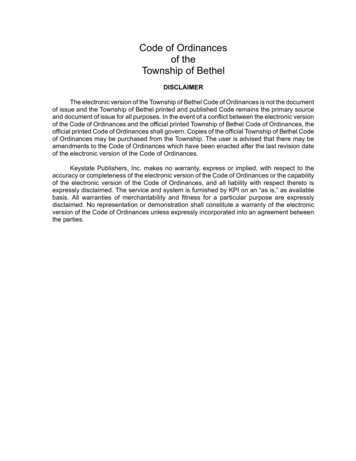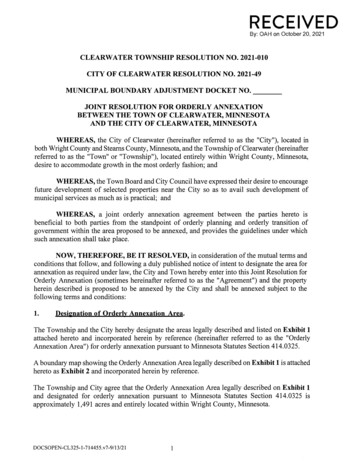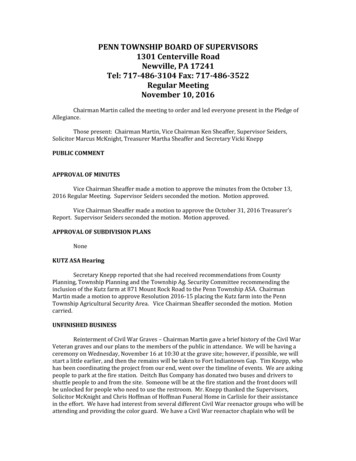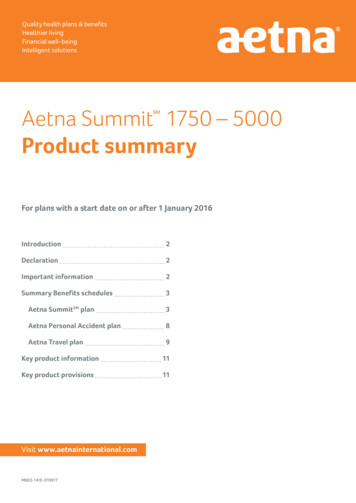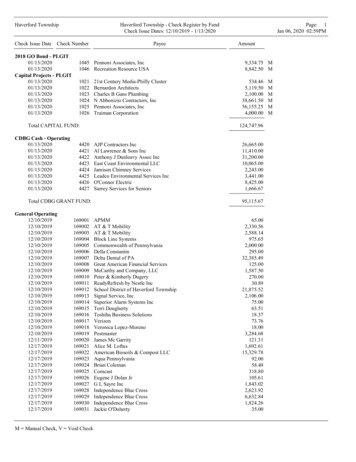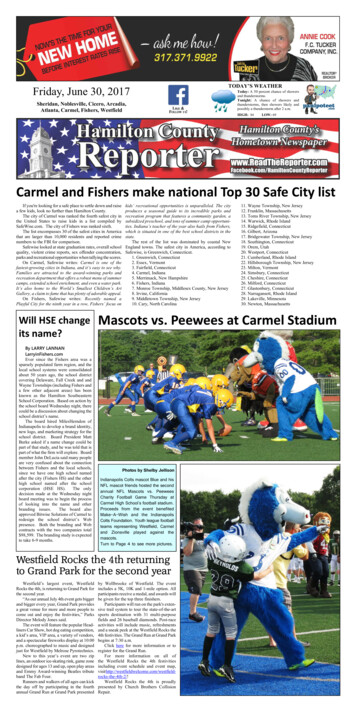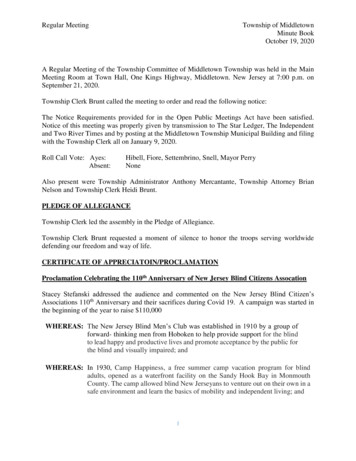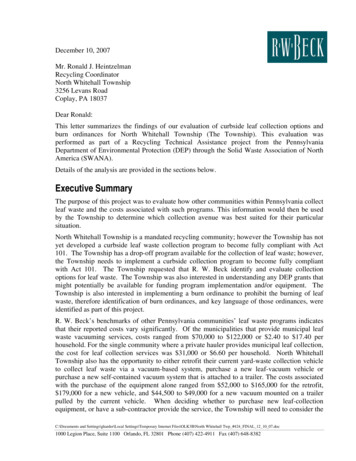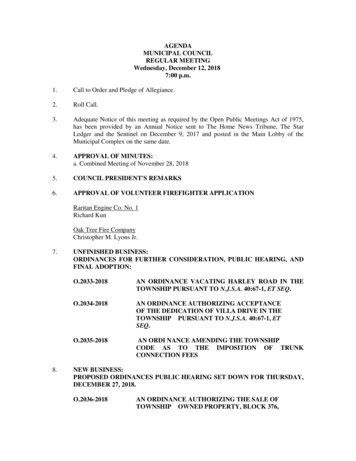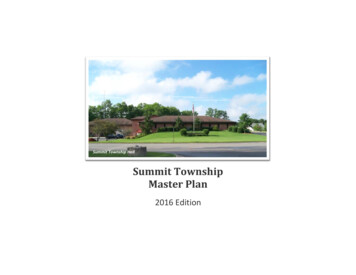
Transcription
Summit Township HallSummit TownshipMaster Plan2016 Edition
The 2016 edition of the Summit Township Master Plan was adopted by the Summit Township Planning Commission on October 18,2016 ·/7/7 .- J / ' //a 4vc- 1it Township Planning Commission ChairThe 2016 edition of the Summit Township Master Plan was approved by the Summit Township Board on November 14, 20167) / ) Summj(T nsh::r \,.:yb.
The 2016 edition of the Summit TownshipMaster Plan was developed by theSummit Township Planning CommissionWith the assistance of theRegion 2 Planning CommissionMr. Bob Smith took the photographs included in the Plan
Table of ContentsIntroduction . 1-1Why Plan .What is a Master Plan .Master Plan Principles .Future Land Use & Zoning .Use of the Master Plan .Keeping the Plan Current .How Did the Plan Develop? .Who Will Implement the Plan? .Planning Commission .Zoning Board of Appeals .Township Board .Other Planning Efforts .1-21-21-21-31-41-61-61-61-61-71-71-7Community Description and Issue Identification . 2-1Location .Population/Demographics .Geology .Topography, Soils & Hydrology .Public Facilities & Services .Minimum Sewer & Water .School Districts .Hazard Mitigation .Arts, Recreation, & Cultural Opportunities .Land Use/Land Cover in the Year 2000 .Summit Township Master Plan, 2016 edition2-22-22-42-52-52-62-62-62-72-7Page iv
Table of ContentsDevelopment since the Year 2000 . 2-10Land Use & Transportation . 2-10Community Policies and Plans . 3-1Mission Statement . 3-2Residential Development Policy . 3-2Office Development Policy . 3-3Commercial Development Policy . 3-3Industrial Development Policy . 3-3Future Land Use . 3-4Limited Use Areas . 3-4Residential Areas. 3-5Low Density Residential Areas . 3-5High Density Residential Areas . 3-6Office Areas . 3-6Commercial Areas . 3-6Industrial Areas . 3-7Zoning Plan . 3-7What is a Zoning Plan? . 3-7Zoning Districts . 3-8Dimensional Standards . 3-11Rezoning Criteria . 3-14Relationship to the Future Land Use Map . 3-14Summit Township Master Plan, 2016 editionPage v
Table of ContentsAppendicesDemographics . A-1Population History . A-2Population Projections . A-3American Community Survey . A-4Generations – Summit Township . A-5Generations – Vandercook Lake . A-6Race & Ethnicity - Summit Township . A-7Race & Ethnicity - Vandercook Lake . A-8Disabilities - Summit Township . A-9Disabilities – Vandercook Lake . A-10Households & Families - Summit Township . A-11Households & Families - Vandercook Lake . A-12Household Income - Summit Township . A-13Household Income - Vandercook Lake . A-14Dwellings & Vacancy Rates - Summit Township . A-15Dwellings & Vacancy Rates - Vandercook Lake . A-16Housing Types - Summit Township . A-17Housing Types - Vandercook Lake . A-18Maps . B-1Base Map .Topography .Soils .Hydrology .Summit Township Master Plan, 2016 editionB-2B-3B-4B-5Page vi
Table of ContentsExisting Land Use . B-6Agricultural & Open Lands . B-7Built-Up Lands . B-8Transportation . B-9Sewer Service Area . B-10Water Service Area . B-11School Districts . B-12Future Land Use . B-13Zoning . B-14Capital Improvements Program . C-1What is a Capital Improvements Program? .Why Prepare a Capital Improvements Program? .Developing a Capital Improvements Program .Establishing Objective Criteria .Establishing a Process .Summit Township Master Plan, 2016 editionC-2C-2C-3C-3C-4Page vii
Table of ContentsSummit Township Master Plan, 2016 editionPage viii
Paragon AcademyCHAPTER 1INTRODUCTION
Chapter 1IntroductionWhy Plan?Municipalities have a vested interest in developing master plans. The master planning process provides an opportunity for municipalities to develop an overall vision for the next 20 years and to conduct a comprehensive review of their facilities and services. A successful Plan also contributes to the public understanding of the planning process and describes how its goals are to be achieved.Section 31 of the Michigan Planning Enabling Act (PA 33 of 2008, MCL 125.3831) requires each planning commission to prepare and adopt a“master plan as a guide for development within the planning jurisdiction.” The MPEA authorizes a planning commission to “do all of the following, as applicable: Make careful and comprehensive surveys and studies of present conditions and future growth within the planning jurisdiction with dueregard to its relation to neighboring jurisdictions;Consult with representatives of adjacent local governments in respect to their planning so that conflicts in master plans and zoning maybe avoided;Cooperate with all departments of the state and federal governments and other public agencies concerned with programs for economic,social, and physical development within the planning jurisdiction and seek maximum coordination of the local unit of government’s programs within these agencies.”What is a Master Plan?A master plan provides a framework within which Summit Township can evaluate its present condition and develop a vision for the future. Themaster plan also serves as the guiding document for land use, development, and zoning decisions. A well-designed and implemented plan whichis kept up-to-date will help Summit Township to continue to be a highly desirable community in which to live, work, and visit.Master Plan PrinciplesBefore using the master plan to guide future development, it is important to understand some of the basic principles upon which it is based: The Plan is flexible — The document is not meant as a monument cast in stone, never to be adjusted or changed given that it plans forthe next 20 years. The plan is a general guide to be used by the government to give direction for the future of Summit Township. Itshould be reviewed periodically and altered as general conditions in the community change.Summit Township Master Plan, 2016 editionPage 1-2
Chapter 1Introduction The Plan allows for orderly development — The land use allocations reflected in the plan are based upon the best available projectionsof future population levels for the Summit area. The plan must realistically provide sufficient land area to meet the anticipated needsand demands of our residents and businesses, while at the same time protecting the overall quality of life and the physical environment.While the document does not require a use which might provide the greatest amount of return on investment in land, it does requirethat property owners receive a reasonable return on their investments. The Plan must encourage public understanding and participation — The plan should be written in a way that aids public understandingof the planning process and describes how goals for Summit Township are to be achieved. The Plan must be the result of a general consensus of the community — Plan elements must be clearly understood by all and followedconsistently to minimize the possibility of arbitrary decision making. A clear consensus is needed during the planning process to ensurethat the Plan will be followed. The Plan must balance property rights —The law requires that all property owners be granted a reasonable use of their property. Thisincludes the rights of adjoining property owners to enjoy their property. The Plan is not a zoning map — The document reflects the planned use of land, taking into consideration existing development, butdoes not depict a "new" zoning district map. Since the plan and zoning map are intended to be in reasonable harmony, it is likely that future zoning districts will take the shape of the plan as rezoning requests are received and reviewed by each community. Zoning is not a substitute for a Master Plan — The plan is a long range guide for community development. Zoning approvals are specificto a piece of property and are always attached to the land. They may not be restricted to an individual. Zoning approvals are alwayspermanent, unless the use itself is temporary in nature. Deviation from the Plan puts zoning decisions at risk of invalidation — Zoning decisions that are not based upon the plan risk invalidation if faced with a legal challenge. Decisions made on the basis of the document may be afforded additional validity, since the decisionwas not made in an arbitrary fashion, but follows a rational plan for the Summit area.Future Land Use & ZoningThe heart of the master plan is its depiction and descriptions for future land use. Determining the future use of land should be based on severalfactors, including:Summit Township Master Plan, 2016 editionPage 1-3
Chapter 1 Community characterAdaptability of landCommunity needsAvailable servicesIntroduction Available servicesExisting developmentExisting zoningThe connection between the master plan and the zoning ordinance of Summit Township is often misunderstood. Accordingly, therelationship between the plan’s future land use map and the zoning maps is a critical one. That link is established through the zoning plan element of the master plan.Use of the Master PlanCompletion of the Master Plan is not the end of the planning process. Continuous and effective use of a Plan is necessary to ensure its validity.Failure to follow a Plan may discredit any attempt to use it as a defense for actions which may be challenged by property owners or developers.Likewise, consistent and vigorous use of a Plan will lend credibility to the community's implementation of controversial decisions on zoning actions. While state courts do not normally recognize the absolute authority of a master plan, they do lend more credibility to actions supportedby careful planning than those which appear to be made arbitrarily. The more common uses of the master plan include: Zoning Decisions — Since the master plan determines the future use of land, rezoning decisions should be consistent with its provisions.This is not to say that all rezonings that are consistent with the future land use map should automatically be approved. However, if all ofthe preconditions of the Master Plan are met, approval of the request may logically be forthcoming.On the other hand, a rezoning request different from that shown in the plan should not automatically be rejected, particularly if the Planhas not been reviewed in some time. Instead, each request should be evaluated to see if the conditions originally considered when theplan was adopted have changed. If so, the plan may deserve reconsideration (but need not necessarily be changed). Utility Extensions/Capital Improvements — A useful function of the master plan is its designation of land use intensity when evaluatingthe need for improved utilities, new roadways and public buildings, and other improvements. This information may be included in a Capital Improvement Plan (CIP). The CIP is a six-year plan, updated annually, for capital expenditures necessary for plan implementation.Development of the CIP is the responsibility of the township board, with considerable input from the municipal staff (e.g., engineers,planners, administrators, etc.) and the planning commission. Its principal elements include project names, descriptions, costs, priorities,Summit Township Master Plan, 2016 editionPage 1-4
Chapter 1Introductionyears to be completed or begun, and potential or planned funding sources. This information provides property owners with some assurance that improvements necessary to implement the Plan are forthcoming, and shows a general schedule of those improvements. Environmental Impact — The master plan (as a reflection of the intensity of land use) should reflect the degree to which Summit Township desires to protect its environment and natural features. The plan should establish that value to the community and propose stepsto implement the appropriate regulations. Recreation Planning — The master plan (through the provision of future residential lands) will create a need for recreation/open spaceland. The master plan can assist in the setting of priorities for park development. For example, parks and recreation plans pay special attention to the goals and objectives of the master plan. If additional recreation services are called for in the plan, these services may benoted in the parks and recreation plan.A review of Future Land Use is also important. If a Master Plan indicates that substantial new residential development will be forthcoming in a particular area, some indication should be made for the need to acquire and develop additional park land. However, the FutureLand Use Map cannot indicate specific properties as park land, unless the land is in public ownership, or steps are already well underwayto acquire that property.In order to qualify for grant programs at the state level, or federal grants administered at the state level, the Michigan Department ofNatural Resources and Environment (MDNRE) requires that Summit Township have a current (no more than 5 years old) parks and recreation plan. The Township does not have a current recreation plan on file with the MDNRE. Approval of a public way, space, building or structure — An often overlooked provision in state law is a requirement that the Townshipplanning commission review any new street, park acquisition, public building, or other similar easement, street, or use, shown in themaster plan, prior to any positive actions taken to implement such improvement. This ensures that the proposed improvement is incompliance with the provisions of the master plan. Although a denial may be overruled by the controlling authority, the review is stillrequired. Transportation Improvements — There is a clear relationship between transportation and land use. As development proceeds, the needfor new or improved roadways becomes obvious. By measuring the intensity of future development shown in the Master Plan, transportation planners can estimate needed rights-of-way widths, number of lanes, and the level of necessary access management.Summit Township Master Plan, 2016 editionPage 1-5
Chapter 1IntroductionKeeping the Plan CurrentAn outdated Plan that is not frequently reviewed can weaken decisions based upon the document. The planning commission should conduct anannual review of the Plan to ensure that it is kept current. Township officials and employees can assist by bringing issues not addressed in thedocument to the attention of the planning commission. Any amendments to the Plan can be done at that time to keep it up to date and consistent with community philosophies. For example, some goals may have been achieved and new ones need to be established. Where useshave been approved contrary to the plan, the document should be amended to reflect these changes. By routinely following this procedure, theMaster Plan will continue to be an up-to-date and reliable planning tool. Even though the plan has a 20 year horizon, a comprehensive updateshould occur at least every 5 years according to the Michigan Planning Enabling Act (MPEA).How Did the Plan Develop?This document is the third update to the Summit Township Master Plan. The Township adopted its first master plan in 1975 and updates to thedocument were completed in 1991 and 2006.Citizen participation is extremely important to the success of almost any planning effort. Citizen participation helps guarantee that the visionoutlined for the future of the Summit area accurately reflects the true goals of its residents. Direct and indirect public input opportunities included: Meetings of the planning commission where the Plan was included on the agenda (open to the public);A community planning survey (provided to a sample of property owners);A public hearing on the Master Plan.Who Will Implement the Plan?Three distinct bodies in the Township are charged with planning and zoning: the planning commission, the zoning board of appeals, and thetownship board. All of their decisions and recommendations should be based upon the Master Plan. Decisions not based upon the Plan shouldtrigger the review and possible amendment of the document.Planning CommissionDevelopment and approval of the Master Plan is an important responsibility of the planning commission. The commission is charged with thedevelopment of zoning and other ordinances (over which the township board has final authority). In this capacity, a subcommittee of the com-Summit Township Master Plan, 2016 editionPage 1-6
Chapter 1Introductionmission met to develop the Master Plan. The planning commission also recommends approval or rejection of requests to the
The 2016 edition of the Summit Township Master Plan was adopted by the Summit Township Planning Commission on October 18, 2016 J/' ·/7/7 .- //a 4vc--1it Township Planning Commission Chair The 2016 edition of the Summit Township Master Plan was approved by the Summit Township Board on November 14, 2016 7) /) ::r \,.:yb._ Summj(T nsh
